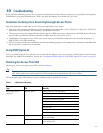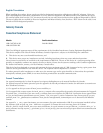
2
1 About this Guide
This Guide provides instructions on how to install and configure your Cisco Aironet 700 Series Access Point. The 700 Series
Access Point is referred to as the 700 series or the access point in this document.
2 Introduction to the Access Point
The 700 series supports high-performing two spatial stream rates over a deployable distance with high reliability when serving
clients. The 700 series provides high reliability and overall wireless performance.
The 700 series offers dual-band radios (2.4 GHz and 5 GHz) with integrated internal antennas. The access point supports full
inter-operability with leading 802.11n clients.
The 700 series access point is available in the controller-based configuration and supports:
• Simultaneous dual-band (2.4 GHz/5 GHz) radios
• Integrated antennas on 702I access point models (AIR-CAP702I-x-K9)
Note The ‘x’ in the model numbers represents the regulatory domain. Refer to “Regulatory Domains” section on page 4
for a list of supported regulatory domains.
The features of the 700 series are:
• Processing sub-systems (including CPUs and memory) and radio hardware which supports:
–
Unified
–
FlexConnect
–
Monitor-mode
• The following processor features:
–
128 MB NAND flash size
–
1 MB NOR flash size
–
128 MB DDR2 memory bus, x32
• 2.4 GHz and 5 GHz 802.11n radios with the following features:
–
802.11n standard compliant
–
A-MPDU TX
–
HT Duplicate Mode
–
2TX x 2RX
–
2-spatial streams, 300 Mbps PHY rate
–
Maximal ratio combining (MRC)
–
Cyclic Shift Diversity (CSD)
–
MCS0-MCS15; Short or Long Guard Intervals
–
DFS for UNII-2 and UNII-2 Extended channels, including 0.5us radar pulse detection
3 Safety Instructions
Translated versions of the following safety warnings are provided in the translated safety warnings document that is shipped
with your access point. The translated warnings are also in the Translated Safety Warnings for Cisco Aironet Access Points,
which is available on Cisco.com.


















